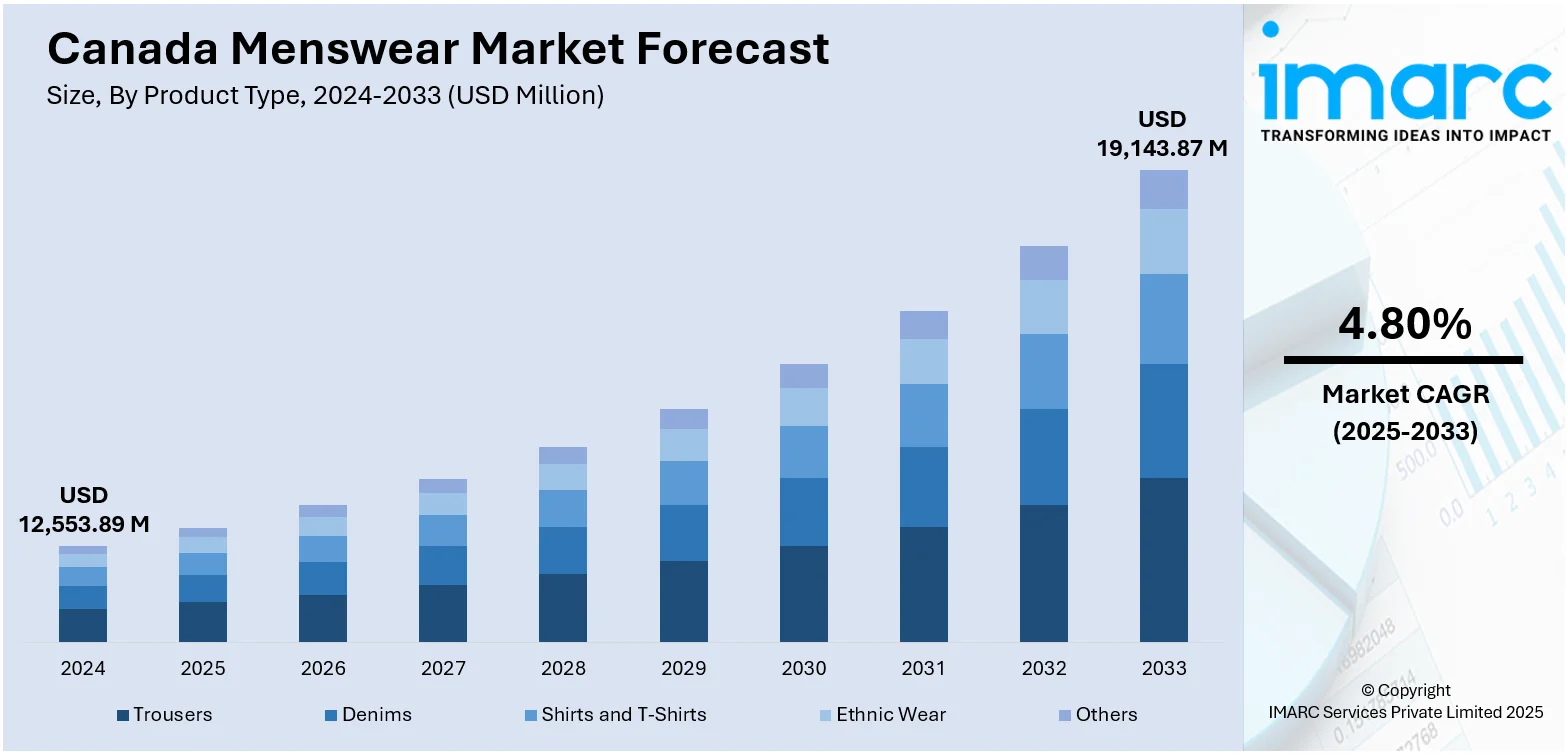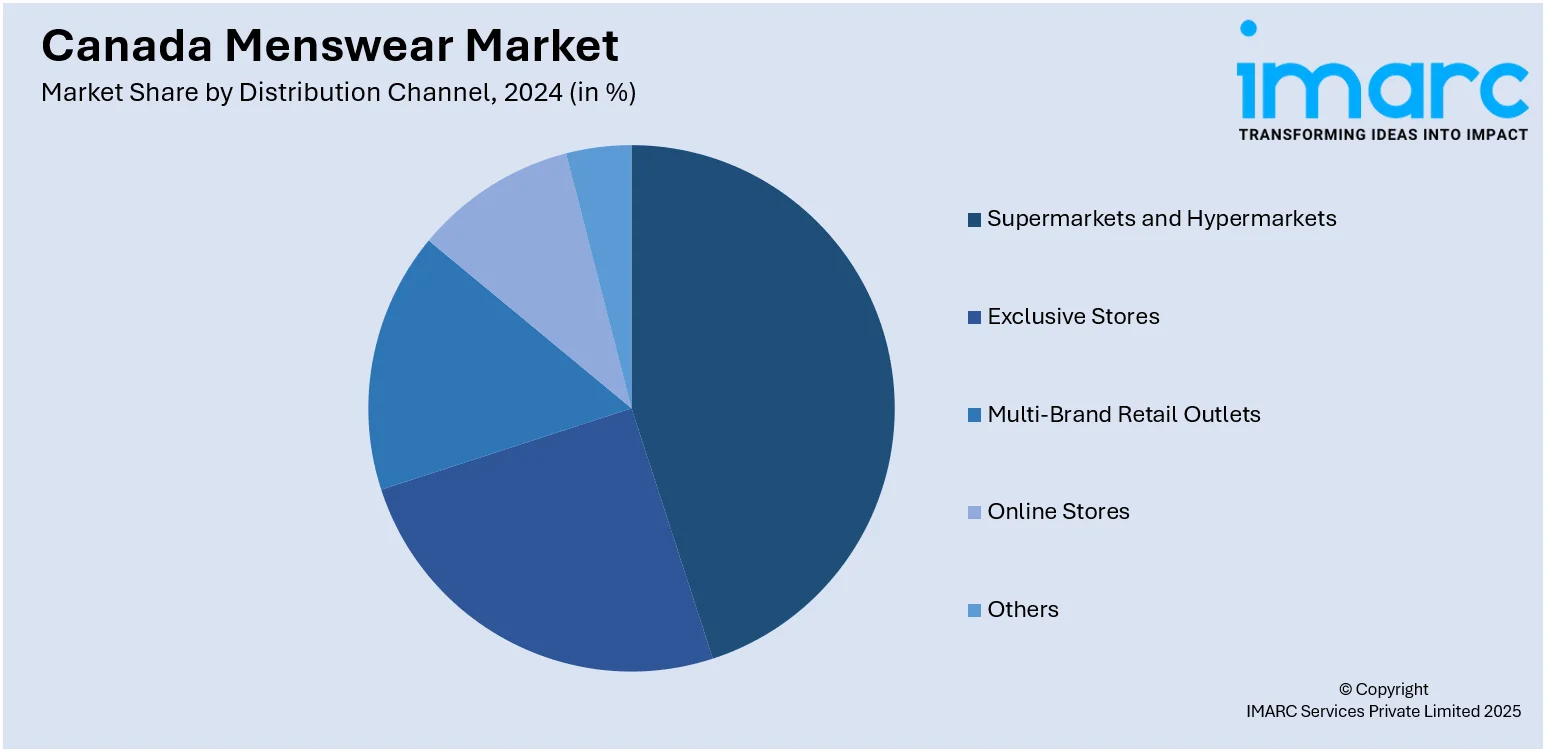
Canada Menswear Market Size, Share, Trends and Forecast by Product Type, Season, Distribution Channel, and Region, 2025-2033
Canada Menswear Market Overview:
The Canada menswear market size reached USD 12,553.89 Million in 2024. Looking forward, the market is expected to reach USD 19,143.87 Million by 2033, exhibiting a growth rate (CAGR) of 4.80% during 2025-2033. The market is experiencing steady growth, driven by rising fashion awareness, increased online shopping, and growing demand for both casual and formal wear. Consumers are showing greater interest in sustainable and versatile clothing options that suit changing lifestyles. As competition intensifies, the Canada menswear market share is shifting toward brands offering innovation, comfort, and value.
|
Report Attribute
|
Key Statistics
|
|---|---|
|
Base Year
|
2024 |
|
Forecast Years
|
2025-2033
|
|
Historical Years
|
2019-2024
|
| Market Size in 2024 | USD 12,553.89 Million |
| Market Forecast in 2033 | USD 19,143.87 Million |
| Market Growth Rate 2025-2033 | 4.80% |
Canada Menswear Market Trends:
Rising Focus on Sustainability
Sustainability is an increasingly important trend in the Canadian menswear market, fueled by the growing consumer desire for environmentally friendly fabrics, ethically produced, and transparent supply chains. Consumers are increasingly judging brands on their social responsibility and environmental impact, giving rise to the growing popularity of clothing made from organic cotton, recycled polyester, and low-impact dyes. To counter this, Canadian men's wear brands are adopting certifications, local production, and transparent sourcing. This is particularly rampant across Millennials and Gen Z populations, who perceive sustainable alternatives as a value reflection. As such green preferences become the new standard, companies that put sustainable means first are gaining a competitive advantage. For instance, in March 2024, Harry Rosen, a high-end menswear retailer, introduced North America's inaugural fully recyclable packaging program in collaboration with TerraCycle, designed to reduce landfill waste. Customers can bring back used garment bags to the stores for recycling and receive loyalty points in return. This initiative underscores the brand's dedication to sustainability as it nears its 70th anniversary. The alignment between consumer expectations and responsible production is a key factor in driving Canada menswear market growth, fostering innovation and long-lasting brand loyalty in the industry.

To get more information on this market, Request Sample
E-Commerce and Omnichannel Evolution
The growth of e-commerce and omnichannel retail is transforming the Canadian menswear sector by providing consumers with a cohesive shopping experience across both digital and physical platforms. Online channels now offer tailored recommendations, virtual fitting options, and convenient click-and-collect services, aligning with consumers' increasing demand for convenience and efficiency. At the same time, physical retail locations are transforming into engaging spaces that incorporate personal styling services, live product demonstrations, and interactive displays to boost customer interaction. For instance, in September 2024, Holt Renfrew launched SKIMS Mens across Canada, both in-store and online. The collection includes comfortable briefs, boxers, and lounge wear, featuring innovative designs in fabric and fit. This launch enhances Holt Renfrew's collaboration with SKIMS, a brand co-founded by Kim Kardashian, known for revolutionizing underwear for various body types. Brands are utilizing data analytics to gain insights into shopping behaviors across various channels, allowing for consistent pricing, clear inventory tracking, and loyalty incentives, regardless of whether purchases are made online or in-store. This integration of various shopping channels is redefining brand approaches, enhancing customer loyalty, and broadening market outreach throughout the country. As omnichannel capabilities continue to advance, they are becoming fundamental to the growth of the Canadian menswear market, establishing a benchmark for competitiveness in modern retail.
Canada Menswear Market Segmentation:
IMARC Group provides an analysis of the key trends in each segment of the market, along with forecasts at the country and regional levels for 2025-2033. Our report has categorized the market based on product type, season, and distribution channel.
Product Type Insights:
- Trousers
- Denims
- Shirts and T-Shirts
- Ethnic Wear
- Others
The report has provided a detailed breakup and analysis of the market based on the product type. This includes trousers, denims, shirts and t-shirts, ethnic wear, and others.
Season Insights:
- Summer Wear
- Winter Wear
- All-Season Wear
A detailed breakup and analysis of the market based on the season have also been provided in the report. This includes summer wear, winter wear, and all-season wear.
Distribution Channel Insights:

- Supermarkets and Hypermarkets
- Exclusive Stores
- Multi-Brand Retail Outlets
- Online Stores
- Others
A detailed breakup and analysis of the market based on the distribution channel have also been provided in the report. This includes supermarkets and hypermarkets, exclusive stores, multi-brand retail outlets, online stores, and others.
Regional Insights:
- Ontario
- Quebec
- Alberta
- British Columbia
- Others
The report has also provided a comprehensive analysis of all the major regional markets, which include Ontario, Quebec, Alberta, British Columbia, and others.
Competitive Landscape:
The market research report has also provided a comprehensive analysis of the competitive landscape. Competitive analysis such as market structure, key player positioning, top winning strategies, competitive dashboard, and company evaluation quadrant has been covered in the report. Also, detailed profiles of all major companies have been provided.
Canada Menswear Market News:
- In April 2025, Vancouver-based menswear brand Champlain announced its partnership with Harry Rosen, expanding into over 50 retail locations since its 2023 launch. Champlain offers versatile styles priced under budget, blending West Coast casual with metropolitan tailoring.
- In June 2024, Rhenus Warehousing Solutions renewed its partnership with Harry Rosen, a luxury menswear retailer in Canada, further strengthening their long-term collaboration. This renewed agreement aims to improve warehousing and distribution processes from their 145,356-square-foot facility located in Greater Toronto. It highlights a shared dedication to excellence in the luxury retail industry, with both companies upholding values of integrity and service.
Canada Menswear Market Report Coverage:
| Report Features | Details |
|---|---|
| Base Year of the Analysis | 2024 |
| Historical Period | 2019-2024 |
| Forecast Period | 2025-2033 |
| Units | Million USD |
| Scope of the Report |
Exploration of Historical Trends and Market Outlook, Industry Catalysts and Challenges, Segment-Wise Historical and Future Market Assessment:
|
| Product Types Covered | Trousers, Denims, Shirts and T-Shirts, Ethnic Wear, Others |
| Seasons Covered | Summer Wear, Winter Wear, All-Season Wear |
| Distribution Channels Covered | Supermarkets and Hypermarkets, Exclusive Stores, Multi-Brand Retail Outlets, Online Stores, Others |
| Regions Covered | Ontario, Quebec, Alberta, British Columbia, Others |
| Customization Scope | 10% Free Customization |
| Post-Sale Analyst Support | 10-12 Weeks |
| Delivery Format | PDF and Excel through Email (We can also provide the editable version of the report in PPT/Word format on special request) |
Key Questions Answered in This Report:
- How has the Canada menswear market performed so far and how will it perform in the coming years?
- What is the breakup of the Canada menswear market on the basis of product type?
- What is the breakup of the Canada menswear market on the basis of season?
- What is the breakup of the Canada menswear market on the basis of distribution channel?
- What is the breakup of the Canada menswear market on the basis of region?
- What are the various stages in the value chain of the Canada menswear market?
- What are the key driving factors and challenges in the Canada menswear market?
- What is the structure of the Canada menswear market and who are the key players?
- What is the degree of competition in the Canada menswear market?
Key Benefits for Stakeholders:
- IMARC’s industry report offers a comprehensive quantitative analysis of various market segments, historical and current market trends, market forecasts, and dynamics of the Canada menswear market from 2019-2033.
- The research report provides the latest information on the market drivers, challenges, and opportunities in the Canada menswear market.
- Porter's five forces analysis assist stakeholders in assessing the impact of new entrants, competitive rivalry, supplier power, buyer power, and the threat of substitution. It helps stakeholders to analyze the level of competition within the Canada menswear industry and its attractiveness.
- Competitive landscape allows stakeholders to understand their competitive environment and provides an insight into the current positions of key players in the market.
Need more help?
- Speak to our experienced analysts for insights on the current market scenarios.
- Include additional segments and countries to customize the report as per your requirement.
- Gain an unparalleled competitive advantage in your domain by understanding how to utilize the report and positively impacting your operations and revenue.
- For further assistance, please connect with our analysts.
 Request Customization
Request Customization
 Speak to an Analyst
Speak to an Analyst
 Request Brochure
Request Brochure
 Inquire Before Buying
Inquire Before Buying




.webp)




.webp)












